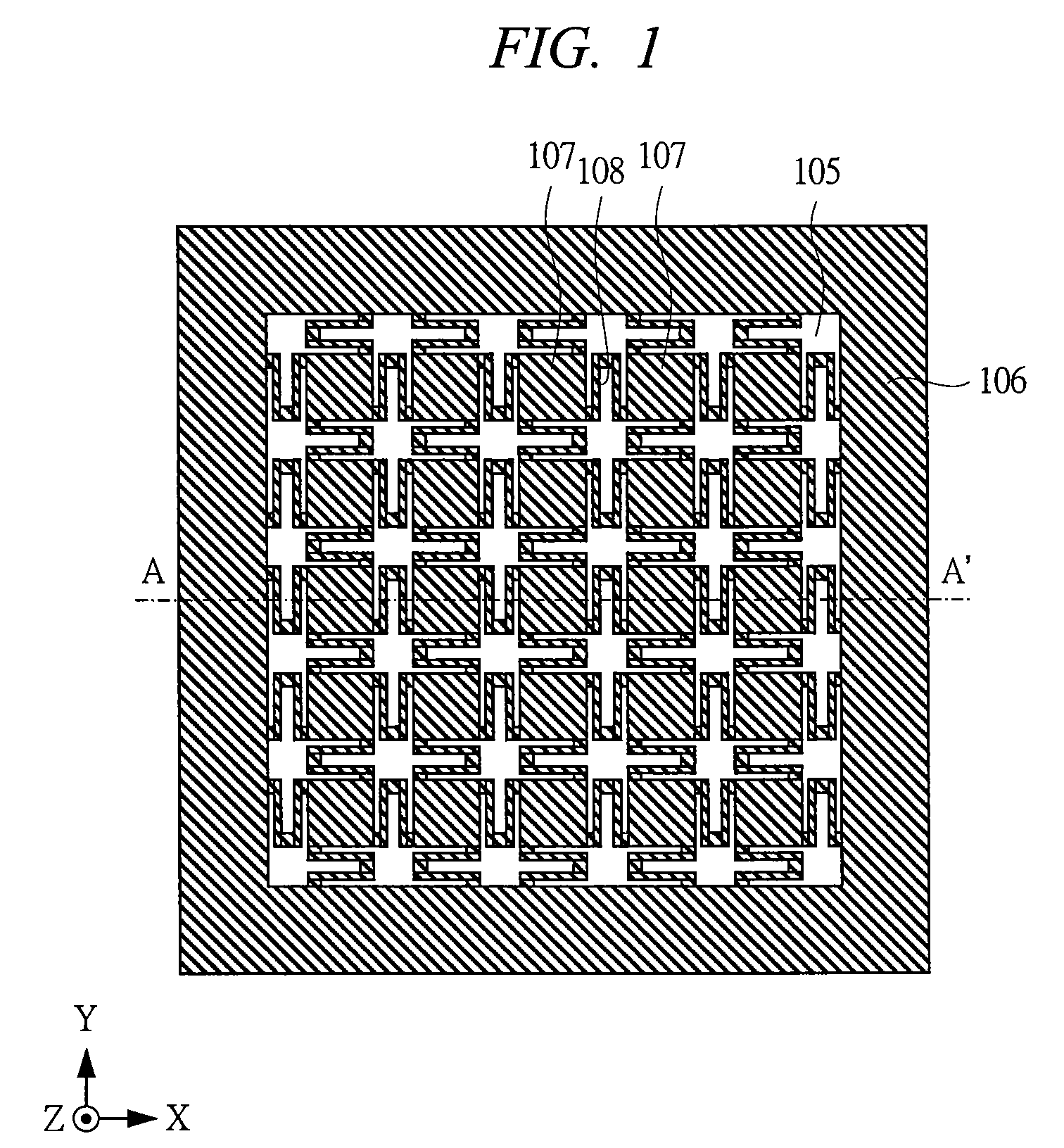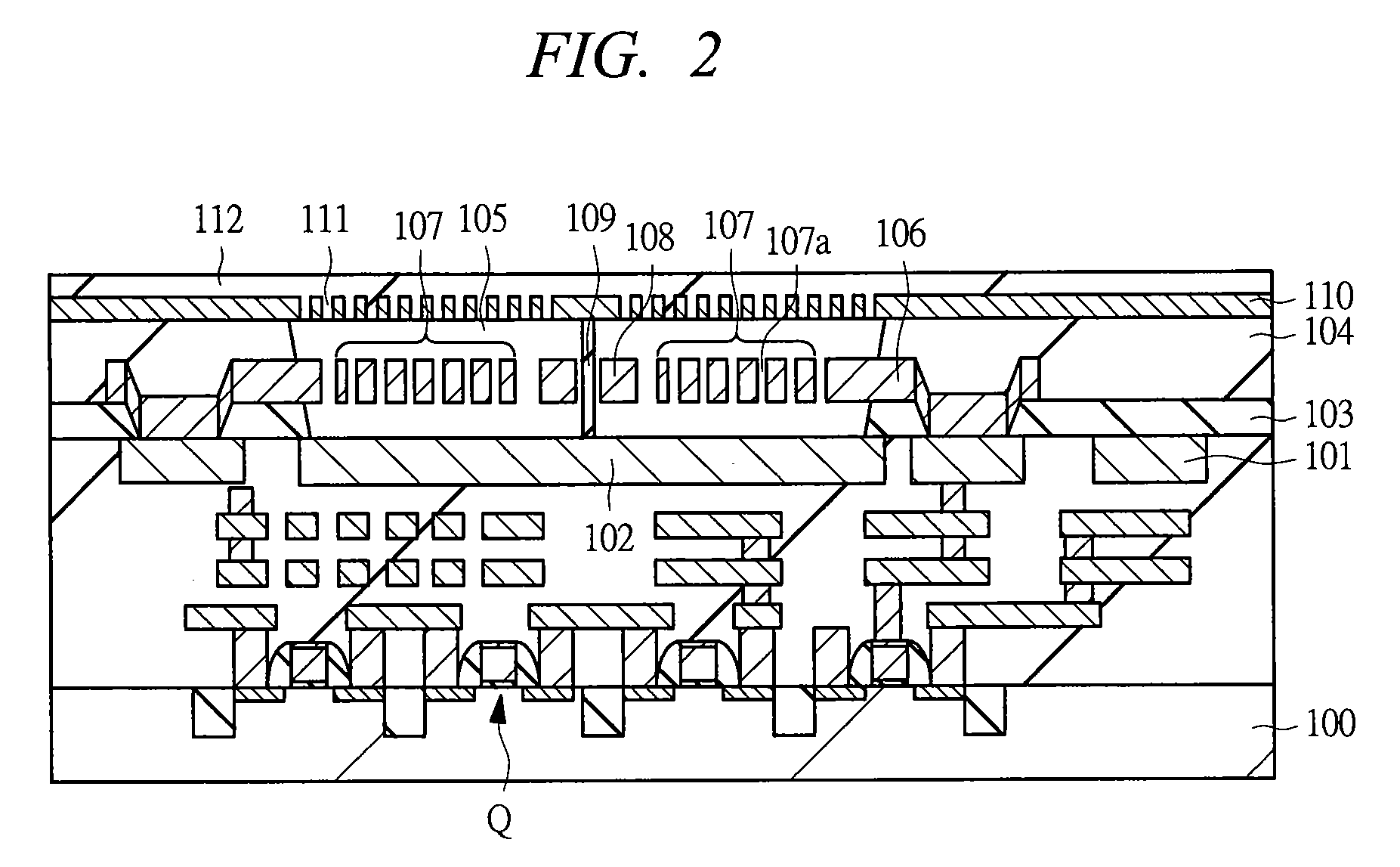Inertial sensor and manufacturing method of the same
a technology of inertial sensor and manufacturing method, which is applied in the direction of acceleration measurement using interia forces, acceleration measurement in multiple dimensions, instruments, etc., can solve the problems of reducing the strength of the beam, affecting the accuracy and unable to achieve the strength (reliability) of the structure body and the sensitivity of the inertial sensor. achieve the effect of wide acceleration range and wide dynamic rang
- Summary
- Abstract
- Description
- Claims
- Application Information
AI Technical Summary
Benefits of technology
Problems solved by technology
Method used
Image
Examples
first embodiment
[0067]An inertial sensor according to the first embodiment will be described with reference to the accompanying drawings. FIG. 1 is a plan view showing a mechanism portion (main portion) of an inertial sensor according to the first embodiment. As shown in FIG. 1, a frame 106 formed by a thin film is formed in the periphery. The frame 106 is fixed to a semiconductor substrate in which the inertial sensor is formed. A cavity portion 105 is formed inside the frame 106, and a plurality of divided weights 107 are arranged inside the cavity portion 105 via a plurality of beams (elastic bodies) 108. In other words, a plurality of divided weights 107 are arranged inside the cavity portion 105 in a two-dimensional manner (in a direction of an X axis and a direction of a Y axis), and the divided weights 107 are connected to each other by an elastically deformable beams 108. The plurality of divided weights 107 formed in the above-mentioned manner are designed to be displaced in a direction of...
second embodiment
[0118]A one-axis acceleration (or vibration) sensor (inertial sensor) according to a second embodiment of the present invention will be described with reference to the accompanying drawings. FIG. 16 is a diagram schematically showing a planar layout of a movable structure body (sensor first layer) of the one-axis acceleration (or vibration) sensor in the second embodiment. FIG. 17 is a schematic cross sectional view for explaining an operation of the one-axis acceleration sensor in the second embodiment. The one-axis acceleration sensor in the second embodiment is also manufactured by the same manufacturing process as the first embodiment mentioned above.
[0119]A divided weights 202 formed in the sensor first layer are formed to have four trapezoidal shapes as shown in FIG. 16. The divided weight 202 is formed inside a cavity portion 201, and the divided weights 202 are connected to each other by beams 203. Each of the divided weights 202 is fixed to a frame 200 of the cavity portion...
third embodiment
[0128]The present invention can be applied also to a sensor which detects an acceleration in a direction parallel to a main surface of the semiconductor substrate. In the third embodiment, an example in which the present invention is applied to an acceleration sensor (inertial sensor) which detects an acceleration in a direction of an X axis will be described with reference to FIG. 21 and FIG. 22.
[0129]FIG. 21 is a schematic diagram showing a planar layout of a movable structure body in a one-axis acceleration sensor according to the third embodiment. FIG. 21 is a schematic diagram for explaining an operation of the one-axis acceleration sensor according to the third embodiment. The weights formed by a sensor first layer include five divided weights 301 to 305 arranged in the direction of the X axis as shown in FIG. 21. The divided weights 301 to 305 are connected to each other by beams, and the divided weight 301 and the divided weight 305 in both ends are fixed to a frame 300 surr...
PUM
| Property | Measurement | Unit |
|---|---|---|
| thickness | aaaaa | aaaaa |
| thickness | aaaaa | aaaaa |
| width | aaaaa | aaaaa |
Abstract
Description
Claims
Application Information
 Login to View More
Login to View More - R&D
- Intellectual Property
- Life Sciences
- Materials
- Tech Scout
- Unparalleled Data Quality
- Higher Quality Content
- 60% Fewer Hallucinations
Browse by: Latest US Patents, China's latest patents, Technical Efficacy Thesaurus, Application Domain, Technology Topic, Popular Technical Reports.
© 2025 PatSnap. All rights reserved.Legal|Privacy policy|Modern Slavery Act Transparency Statement|Sitemap|About US| Contact US: help@patsnap.com



